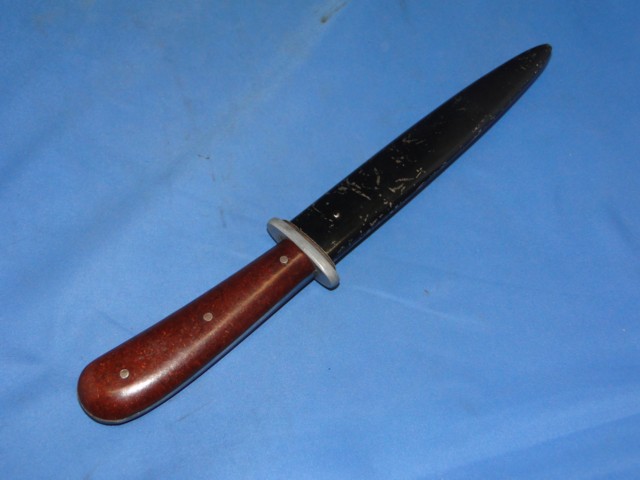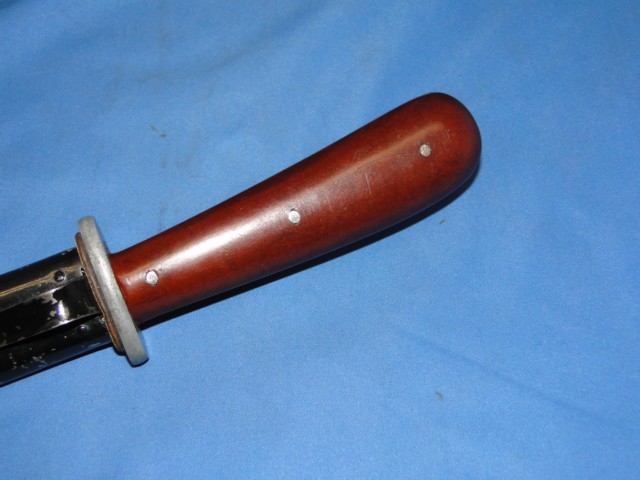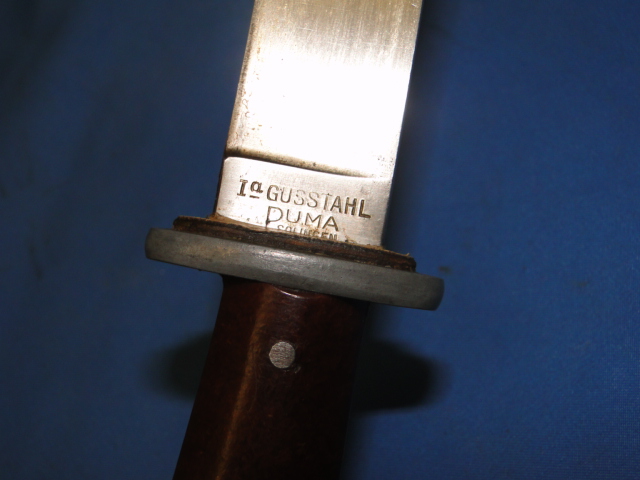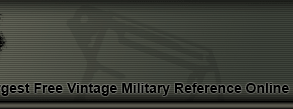WWII German Army Fighting Knife -
The Third Reich issued a large number of edge weapons to the military and civilian organizations. somne of these blades were meant for combat while others were simply a status symbol. The high quality of construction and beautiful designs make these items desirable military collectibles.
The fighting knife featured here was originally designed during WWI. It was widely employed in the trench warfare that
took place during the conflict.

The design of the fighting knife is very compact. There were many variations of this knife produced during
WWI and WWII. The primary difference among them were the handle construction and blade design.
The handle is made of dark brown bakelite. Really nicely rounded off. Held together by three small brass
rivets.

The scabbard is made of metal. Painted black. One side has a spring loaded clip which was used to attach the knife to
the inside of the boot or utility belt. This feature is the reason why the knife is commonly referred to as the
boot knife.
The overall design is very slick and compact.

|
This page is a recognition and identification guide for German bayonets. Multiple
detailed photos of a specific sample are provided. Descriptions point out specific
points that should be noted.
One of the most commonly asked questions is "How much is my German bayonet worth?".
A price guide is included here to address this question. The value of the Nazi bayonets is
reviewed over a period of several years. A trend can be observed. The present worth
of the police sword in the collector's market is illustrated.
This service is provided free of charge to the visitor/enthusiast courtesy of
MilitaryItems.com,
a company dedicated
to the preservation of military history and to providing quality military antiques and
collectibles to museums, institutions and the general public.
|
|

The knife was manufactured by the Puma company of Solingen. The company was well known for poducing high
quality products. They remain in business at the present time.
The Puma name is stamped at the base of the blade. Additional stampings include the word 1a Gusstahl.
Some of the blades came marked with the
branch of service to which the knife was issued.
A leather stopper is visible at the base of the blade. This was a common characteristic of German edge
weapons. It was intended to provided a better seat between the knife and the scabbard.
The blade is of a single edge design. The point has two edges. The crossguard is a single piece of
oval metal.

Many German edge weapons are currently
reproduced.
It is becoming more difficult to be able to tell the fake ones from the real ones because
the quality of the reproductions is improving. The collector must become familiarized with
the construction style and materials employed in the manufacturing of this item.
Attention to the details is critical in order to be able to determine the authenticity of
the collectible.
If you have an interest is seeing other edge weapons of the Third Reich, you can do so by going
to our
WWII German daggers and Swords
identification guide, Where we cover blades from the Heer (Army), Navy (Kriegsmarine), Air Force
(Luftwaffe) and other organizations.
|







